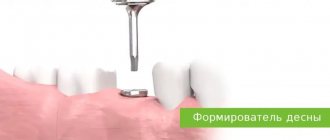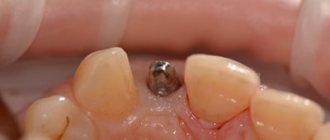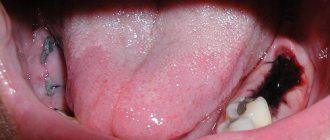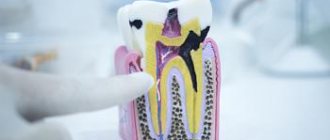Implantation is considered a safe and effective procedure, since in most cases there are no serious complications and the new tooth takes root well. But not everything is rosy. During the adaptive period, many unpleasant things can await you.
After implantation, the gums often become inflamed, visible swelling of the jaw appears, and the temperature rises. In the next three days, the intensity of the processes may increase, but in the normal course of events, already on the sixth to eighth day everything will return to normal.
It is very important to understand whether everything is going according to plan or whether specialist intervention is required. Let's figure out what consequences can be considered acceptable, and for what symptoms it is better to call a doctor immediately.
What not to do after dental implantation
First of all, you need to pay attention to the prohibitions during the rehabilitation period. Most of them act in the first one or two weeks when the wound is healing. Some actions can cause bleeding, suture rupture, and hematoma formation.
Forbidden:
- eat spicy, hard, hot or too cold food;
- touch the area of the wound or the installed implant;
- drink through a straw;
- chew on the side of the jaw where surgery was performed;
- use a toothbrush with stiff bristles;
- fly by plane, dive into the depths with scuba gear, especially when performing a sinus lift;
- smoke;
- drink alcoholic beverages;
- high physical activity: sports, heavy physical labor;
- overheat the body: go to the bathhouse, sauna, sunbathe on the beach, take a hot bath;
- supercool;
- ignore taking prescribed medications.
The rules are especially relevant after flap surgery, which is performed during the classical installation of implants. However, even with a minimally invasive procedure using one-stage protocols (one-step, basal), you should not neglect medical recommendations.
How to relieve swelling after dental implantation
After surgery, the soft tissue in the surgical area swells. This is a normal reaction of the body. Swelling can spread to the tongue, chin, cheeks, causing the face on the side of the installed implant to look swollen. In this case, the patient feels numbness, but normally it should last no more than two or three days. If the symptom lasts longer, it may indicate nerve damage. The most effective way to relieve severe swelling is a cold compress. You can use ice or frozen food from the freezer. Ice is wrapped in a towel and applied to swollen tissues for 10 - 15 minutes. Carry out the procedure several times a day. Do not overdo it with an ice compress, otherwise you can overcool the tissues.
You need to exclude foods that increase swelling from your diet. You cannot eat spicy, salty foods, add spices to your food, or drink coffee. For example, the latter product increases blood pressure, blood rushes to the head, swelling intensifies, and bleeding from the wound may begin.
If the swelling does not go away within three or four days, the pain does not subside, redness of the mucous membranes is observed, pus and fistulas appear, then these are symptoms of peri-implantitis. It is necessary to urgently consult a doctor. Self-treatment can worsen the situation, including implant rejection.
When to see a dentist for help
It has already been said above how facial swelling develops normally, and how many days after dental implantation it should go away. Now let's focus on pathological conditions - after all, you need to be able to distinguish the norm from complications[1], which require medical attention:
- the swelling is very large, the skin of the cheek is red,
- the swelling has not decreased in size 4-5 days after surgery,
- the swelling subsided, and a few days later it appeared again,
- bleeding from the wound does not stop or intensifies,
- pus appeared from wounds, from under dentures or putrid odor from the mouth,
- the temperature does not decrease for more than 3 days or suddenly “jumped” after normalization of the condition,
- noticeable numbness of the cheek or tongue does not go away 2-3 days after surgery,
- The stitches on the gum have come apart.
Beam prosthesis RUB 180,000.
Preparation of the oral cavity, individual bar with installation, taking impressions, manufacturing, installation and fitting of dentures. The price is for 1 jaw. Work guarantee up to 2 years! Consultation with a doctor is free! Call now: +7 (495) 215-52-31
Antibiotics and other medications after dental implantation
Antibacterial drugs are prescribed to prevent the development of infection. Some doctors believe that you should only take antibiotics if you are at high risk, for example, if your immune system is reduced, you have chronic diseases of the upper respiratory tract, periodontitis, or you have had several implants installed at once. However, many dentists insist on the need for antibiotic therapy.
For the purpose of prevention, broad-spectrum drugs are prescribed: penicillins, cephalosporins. The doctor can prescribe any available drugs: Lincomycin, Amoxiclav, Flemoxin, Tsifran ST. Antibiotics must be taken strictly according to the schedule, in the appropriate dosage.
To prevent or relieve inflammatory processes, ointments or gels for external use are prescribed: Metronidazole, Solcoseryl. The latter drug improves metabolic processes in tissues and promotes rapid healing of wounds.
In the first weeks of the rehabilitation period, it is recommended to rinse your mouth after eating with antiseptic solutions: Chlorhexidine, Miramistin and their analogues. You can prepare decoctions of medicinal herbs: oak bark, chamomile, calendula, sage.
Why we want to reduce swelling and how ice works
In addition to an aesthetic defect, large edema carries a potential risk of complications due to compression of soft tissues. The accumulation of fluid compresses small vessels, which leads to disruption of nutrition in the operation area. This is why we prescribe a drip with a decongestant component during major operations, and at home we recommend applying ice. Ice should be kept at the area of interest for 20 minutes every two hours, and so on for the first 48 hours after surgery. How it works? Cold leads to muscle spasms - that’s why we say in the cold that “the cheekbones are cramped and teeth don’t touch teeth.” Our arteries - the vessels that bring blood to the operation area - also have a muscle layer. This is part of our blood supply - organs receive oxygen and nutrients through arteries; such vessels have thick walls in order to quickly respond to changes in the body. The edema itself is formed from the liquid part of the blood - the fluid comes out (leaks) through the vascular walls as a result of the action of the inflammatory mechanism. Blood with carbon dioxide flows through the veins for a new stage of gas exchange. The muscle layer in the veins is less pronounced than in the arteries, and is often absent. It is this property that allows us to reduce swelling when applying cold - we force the arteries to contract and limit the delivery of fluid while maintaining outflow. And here it is important not to overdo it, so as not to deprive the operation area of nutrients, so you must strictly adhere to the doctor’s recommendations.
What you can and cannot eat after dental implantation
On the first day of surgery, you can eat after three or four hours, when the wound has healed. Food should be liquid or pureed, at a comfortable temperature. You should not eat foods that can injure the mucous membranes. The diet must be followed for at least three weeks.
During the recovery period you need to eat:
- soft or liquid food: you can puree foods with a blender, buy baby food in jars;
- foods rich in calcium and vitamins;
- warm food;
- drink plenty of fluids.
You cannot eat seeds, nuts, sour, salty, spicy foods, sweets, alcohol, coffee, hot or cold foods. Smoking is strictly prohibited.
When are sutures removed after dental implantation?
The date of suture removal is determined by the doctor, focusing on the condition of the gum tissue. Usually the procedure is prescribed after 10 - 14 days. If the wound does not heal well, this time can be increased to three weeks.
Sutures should not remain in the gums for too long, as this can lead to the development of inflammatory processes. Self-absorbing suture material does not need to be removed.
How to remove stitches:
- treat the oral mucosa with antiseptics;
- cut the thread stitches in half;
- remove the cut material with tweezers;
- antiseptic treatment is repeated;
- apply a sterile bandage.
Small wounds in the gums heal after one or two days. At this time, discomfort and pain may occur.
If the stitches come apart, they are removed immediately. This phenomenon usually occurs with severe inflammation.
How to brush your teeth after implantation
One of the most important issues concerns oral hygiene in the postoperative period. Teeth should be brushed carefully, avoiding the operated area. It is recommended to use a brush with soft bristles, which cannot injure the mucous membranes of the mouth. Hygiene procedures should be carried out in the morning and evening. When brushing your teeth, you should not forget to remove plaque from the tongue, palate and the inside of the cheeks.
In the first week after eating, it is recommended to rinse the mouth with antiseptics, and then with mouth rinses. When the wound has healed, you can use brushes, dental floss, and irrigators to clean your teeth.
Are swollen gums and other advanced symptoms signs of peri-implantitis?
Peri-implantitis is characterized by inflammation of the tissue around the implant and loss of supporting bone. Leads to rejection of the structure and can develop due to:
- medical error;
- low quality implants;
- insufficient oral hygiene.
In the early postoperative period, complications are caused by technical errors during the operation. In the long term - by ignoring hygiene standards.
Medical errors that provoke the development of peri-implantitis:
- violation of asepsis, antiseptics;
- incorrect assessment of risk factors;
- incorrect selection and installation of an implant;
- incorrect crowns, dentures causing periodontal trauma.
Patients at risk for peri-implantitis include:
- with bad habits (smoking);
- periodontal diseases;
- immune diseases;
- bruxism;
- diabetes mellitus
According to the clinic, peri-implantitis can be:
- sharp;
- sluggish;
- in remission;
- in a state of abscess.
It is important to distinguish between peri-implantitis and mucositis - inflammation of the mucosal area adjacent to the implant, not accompanied by a decrease in bone tissue.
How to make a diagnosis
To establish a diagnosis, the doctor examines the patient. During the inspection it is noted:
- swelling of soft tissues;
- bleeding gums on probing;
- discharge of pus from the peri-implant pocket;
- mobility of the structure;
- the presence of soft plaque on the implant and teeth that are nearby.
Clinical methods for diagnosing peri-implantitis are:
- dental radiography;
- stomatoscopy;
- orthopantomography;
- three-dimensional computed tomography;
- determination of standard dental indices.
How is peri-implantitis treated?
Treatment of the complication is carried out in two stages. First is carried out:
- professional oral hygiene;
- treatment with ozonated solution;
- laser therapy.
The surgical stage of treatment involves:
- revision of the bone pocket;
- removal of necrotic tissue;
- cleaning the surface of the implant with antiseptic agents;
- washing the bone pocket;
- introduction of osteoconductive material into it.
Afterwards, antibiotic therapy and rinsing with antiseptics are prescribed. In case of relapse, removal of the structure and subsequent reimplantation is required.
Why do headaches occur after dental implantation?
Surgery is accompanied by various ailments, including headaches. This is due to the activation of the body's immune system. In some patients, along with pain, body temperature rises.
Normally, the head may hurt for three days. At this time, you need to take painkillers. If the symptom persists for more than four days, it may indicate inflammation around the implant or an allergic reaction to metals.
If, in addition to pain in the mouth, there is a metallic taste, bitterness, sleep is disturbed, and constant weakness is felt, then you should consult a doctor.
Unpleasant sensations after installing a dental implant
Since the gum tissue is severely injured, the patient feels pain for several days. There may be a feeling of fullness and pressure. This is considered normal, since a foreign element was installed in the gum. Unpleasant sensations can persist for one, two weeks or longer, it all depends on the individual characteristics of the body.
Some patients complain that the installed chewing teeth put pressure on the tongue. This may be a subjective sensation, since after removal of the painters the implantation site was empty. Perhaps an error was made during the manufacture of the prostheses. To clarify the issue, you need to consult a doctor.
Possible complications
Swelling after installation of a dental implant is normal, but it can increase and persist for a long time due to pathologies; you can read more about the complications at the link. After surgery, complications may arise due to the fault of the doctor, the patient or extraneous factors (exacerbation of body diseases, individual characteristics). Possible complications:
- Inflammation of soft tissues;
- Bleeding;
- Seam divergence
- Peri-implantitis;
- Infection and gum suppuration.
How long does it take for dental implants to take root?
The processes of osseointegration depend on various factors: the patient’s health status, implantation method, type, brand of implantation system. Conventional classical implants take root in the lower jaw within 3.4 months, in the maxillary region - 5.6 months, since the upper jaw bone is less dense.
Some premium implant models have a special coating that accelerates osseointegration processes. If dental structures are made of pure titanium, then healing occurs faster.
What else do patients ask about after implantation?
Since the installation of implants is a surgical operation, people are interested in many questions about the rehabilitation period.
- Does it hurt to remove stitches? The procedure is carried out after the wound has healed, so removing thin threads does not cause pain. If the patient experiences severe fear, the doctor may treat the suture area with an anesthetic gel or spray.
- Why is smoking prohibited after implantation? Nicotine constricts blood vessels, slows down metabolic processes, and impairs tissue nutrition. This negatively affects wound healing and implant healing. If the patient cannot quit smoking for a long time, the doctor has the right to refuse surgery.
- Why is Dexamethasone prescribed after implantation? The drug can be used as a powerful pain reliever. If the risk of inflammation is very high, then Dexamethasone is prescribed along with antibiotics. The drug quickly stops inflammatory processes and alleviates acute symptoms.
- How long does a tooth hurt after implant placement? Painful sensations persist for 3 - 5 days. If the pain is severe, you can take painkillers.
Average cost in Moscow
Removing a tumor after implantation at home does not require large expenses. The approximate cost of the drugs is given below.
| Name of service | Cost, rub. |
| Synthetic antiseptics | |
| Chlorhexidine | 16 |
| Furacilin | 75 |
| Miramistin | 340 |
| Eludril | 410 |
| Herbal antiseptics | |
| Yarrow | 40 |
| Elecampane | 50 |
| Air | 55 |
| Chamomile | 60 |
| Stomatophyte | 180 |
| Ointments and gels | |
| Asepta | 240 |
| Kamistad | 260 |
| Holisal | 315 |
| Solcoseryl | 370 |
Treatment of complications in dentistry
| Name of service | Cost, rub. |
| Consultations | |
| Dentist | 600 |
| Periodontologist | 740 |
| Implantologist | 820 |
| Healing procedures | |
| Removing dental plaque in the area of one tooth | 180 |
| Periodontal applications in the area of one tooth | 370 |
| Application of a protective periodontal bandage | 400 |
| Laser therapy of the gum mucosa | 490 |
| Implant removal | 6900 |
| Implantation of osteoconductive material in the area of one tooth | 10900 |
| Implantation of a protective membrane | 12900 |











